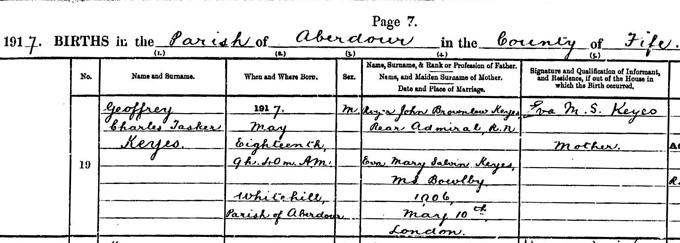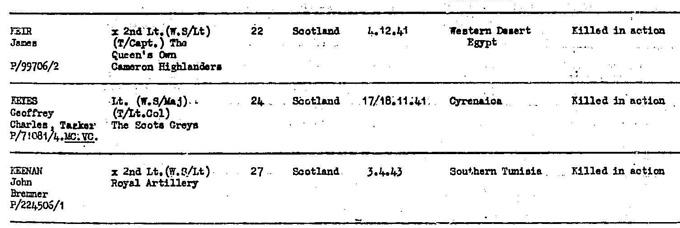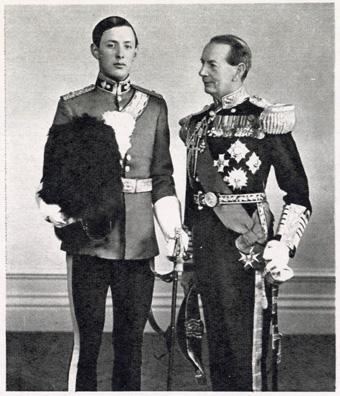Geoffrey Charles Tasker Keyes was born in Aberdour, Fife, on 18th May 1917. He was the son of Roger John Brownlow Keyes, who had just been promoted to Rear Admiral in the Royal Navy, and his wife Eva Mary Salvin Bowlby. At the time of Geoffrey’s birth, his father had been stationed with the Grand Fleet at Scapa Flow and the family were living in a temporary home in Aberdour.

Geoffrey Keyes birth entry, 18th May 1917.
Crown copyright, National Records of Scotland (NRS), Statutory Register of Births, 1917, 401/19 page 7
The year after Geoffrey was born, in the spring of 1918, Rear Admiral Keyes led the audacious and famous raids by British vessels and marines on the German naval bases at Zeebrugge and Ostend. Years later, during the early period of the Second World War, he was the first Director of Combined Operations. This was a department of the British War Office, created to harass the Germans on the European Continent by carrying out raids led by both naval and army forces. He served from 17th July 1940 to 27th October 1941 when he was replaced by Lord Louis Mountbatten and the then Major Robert Laycock.
As a young boy, Geoffrey Keyes lived in various places in southern England and Malta. From the age of nine he was educated at English boarding schools, including Eton. He had originally hoped to follow his father by enlisting in the Navy, however his imperfect eyesight meant that he was not accepted and he joined the Army instead where he was commissioned into the Royal Scots Greys.
Keyes was the youngest Lieutenant Colonel in the British Army, and was only 24 when he was killed. During the war he saw action in Syria, Cairo and fought the Vichy French forces in Lebanon in 1941.
In his final assignment, with the 11th Scottish Commandos, he played a major part in the unsuccessful ‘Operation Flipper’ – an attack on a villa that was thought to be the headquarters of Erwin Rommel (the famous German general) in North Africa on 18th November 1941. Its purpose was to disrupt enemy organisation before the start of Operation Crusader. Faulty intelligence meant that they missed their target; it was believed that Rommel was inside the house when in fact he was in Rome and had never used the house. In the confusion of the attack Keyes was fatally shot, possibly accidentally by one of his comrades. He was awarded a posthumous Victoria Cross for this and also a Military Cross for gallantry in Syria.
The Ballymena Observer reported on 26th June 1942 that Keyes led the raid 250 miles behind enemy lines and had ‘deliberately selected for himself command of the detachment detailed to attack what was undoubtedly the most hazardous…objective – the residence and headquarters of the General Officer Commanding the German Forces in North Africa. This attack, even if initially successful, meant almost certain death for those who took part in it.’
Colonel Keyes and his men had arrived behind enemy lines on boats, the majority of which were swamped on the passage to the beach. The men were able to dry themselves in a cave by a fire and waited for a day in the cover of a dry riverbed. On the second night Keyes ventured with his detachment towards his objective in deteriorating weather. They faced a climb of 1,800 feet in complete darkness and marched towards the German Headquarters for over 18 miles. When they reached their target, due to multiple issues, Keyes was only supported by two men - Captain Campbell and Sergeant Terry.
Keyes crawled past guards to reach the front door of Rommel’s villa. Captain Campbell spoke excellent German and on Keyes’ orders demanded access to the property. When the sentry opened the door, a struggle ensued and Keyes was forced to shoot him, alerting other guards. He led the charge into one room, shooting the enemy. Upon opening a second door he was immediately shot. His comrades carried him outside where he died a few minutes later. He was buried with full military honours in a Catholic cemetery with Rommel’s personal chaplain leading the ceremony.

Keyes’ death entry (shown here in the centre) in the service return papers, 1941.
Crown copyright, NRS, Statutory Register of Deaths, 149/AF 49
Commenting on the raid that killed Keyes, Sir Winston Churchill said ‘I would far rather have Geoffrey alive than Rommel dead’ (The Sphere, 21st July 1956).
Geoffrey Keyes’ medals were purchased at auction in 1995 and are on display in The Lord Ashcroft Gallery: Extraordinary Heroes, Imperial War Museum, London. For more information please visit Keyes’ page on The Comprehensive Guide to The Victoria and George Cross website.

Admiral of the Fleet Sir Roger Keyes with his son Geoffrey in the full dress uniform of a subaltern in the Royal Scots Greys.
Courtesy of the Mary Evans Picture Library.
If you are interested in finding out more about the statutory birth and statutory death registers mentioned in this article, please see our online guides.